Complete Solutions to Multiple choice questions-I of chapter PROPERTIES OF BULK MATTER of Class 11 book with complete answers and questions
| Class 11 | PHYSICS |
| Chapter | PROPERTIES OF BULK MATTER |
| PRADEEP | Multiple choice questions-I |
| Number Of Questions | 100 |
| Academic Year | 2023-24 |
Modulus of rigidity of a liquid
03:09View SolutionThe maximum load a wire can withstand without breaking, when its length is reduced to half of its original length, will
01:05View SolutionThe temperature of a wire is doubled. The young's modulus of elasticity
01:28View SolutionA spring is stretched by applying a load to its free end. The strain produced in the spring is
02:10View SolutionA rigid bar of mass `M` is supported symmetrically by three wires each of length `l`. Those at each end are of copper and the middle one is of ion. The ratio of their diameters, if each is to have the same tension, is equal to
04:22View SolutionA mild steel wire of length `1.0m` and cross sectional area `2L` is strethched, within its elastic limit horizontally between two pillars(figure). A mass of `m` is suspended form the midpont of the wire. Strain in the wire is
 02:37View Solution
02:37View SolutionA recantangular frame is to be suspended symmetrically by two strings of equal length on two supports (figure).It can be done in one of the following three ways:
 01:52View Solution
01:52View SolutionConsider two cylindrical rods of indentical dimesnions, one of rubber and the other of steel. Both the rods are fixed rigidiy at one end to the roof. `A` mass `M` is attached to each of the free ends at the centre of the rods.
04:45View SolutionA tall cylinder is filled with viscous oil. A round pebble is dropped from the top with zero initial velocity. From the plot shown in figure, indicate the one that represents the velocity `(v)` of the pebble as a function of time `(t)`
01:40View SolutionWhich of the following diagrams does not represent a streamline flow?
01:14View SolutionA long a steamline
03:28View SolutionAn ideal fluid flows through a pipe of circular cross-section made of two sections with diameters `2.5 cm` and `3.75 cm`. The ratio of the velocities in the two pipes is
01:51View SolutionThe angle of contact at the interface of water glass is `0^(@)` ethylalcohol-glass is `0^(@)` mercury glass is `140^(@)` and methyliodide-glass is `30^(@)` A glass capillary is put in a through containing one of these four liquids. It is observed that the meniscus is convex. The liquid in the through is
01:46View SolutionA bimetallic strip is made of aluminium and steel `(alpha_(Al)gtalpha_(steel)`. On heating, the strip will
01:23View SolutionA uniform metallic rod rotates about its perpendicular bisector with constant angualr speed. If it is heated uniformly to raise its temperature slightly, then
02:38View SolutionThe graph between two temperature scales `A` and `B` is shown in Fig. Between upper fixed point and lower fixed point there are `150` equal divisions on scales `A` and `100` on scale `B`. The relation between the temperature in two scales is given by_
_S01_001_Q01.png) 02:17View Solution
02:17View SolutionAn aluminium sphere is dipped into water. Which of the following is true ?
01:28View SolutionA the temperature is increased, the time period of a pendulum
01:13View SolutionHeat is associated with
02:47View SolutionThe radious of a metal sphere at room temperature T is R, and the coefficient of linar expansion of the metal is `alpha`. The sphere is heated a little by a temperature `Delta T` so that its new temperature is `T+ Delta T`. The increase in the volume of the sphere is approximately
01:33View SolutionA sphere a cube and thin circular plate, all made of the same material and having the same mass are initially heated to a temperature of `1000^(@)C`. Which one of these will cool first?
02:33View SolutionThe approximate depth of an ocean is `2700m`. The compressibility of water is `45.4xx10^(-11)Pa^-1` and density of water is `10^3(kg)/(m^3)`. What fractional compression of water will be obtained at the bottom of the ocean?
02:26View SolutionThe Young's modulus of steel is twice that of brass. Two wires of the same length and of the same area of cross section, one of steel and another of brass are suspended from the same roof. If we want the lower ends of the wires to be at the same level, then the weight added to the steel and brass wires must be in the ratio of
02:32View SolutionA pendulumd made of a uniform wire of cross sectional area (A) has time T.When an additionl mass (M) is added to its bob, the time period changes to `T_(M). If the Young's modulus of the material of the wire is (Y) then `1/Y` is equal to:
04:39View SolutionThe bulk modulus of a spherical object is `B` if it is subjected to uniform pressure `p`, the fractional decrease in radius is:
01:26View SolutionA man grows into a giant such that his linear dimension increase by a factor of 9. Assuming that his density remains same, the stress in the leg will change by a factor of
01:51View SolutionA material has Poisson's ratio 0.20. If a uniform rod suffers a longitudinal strain `2xx10^(-3)`, then the percentage change in volume is
05:06View SolutionWires `A` and `B` are made from the same material. `A` has twice the diameter and three times the length of `B`. If the elastic limits are not reached, when each is stretched by the same tension, the ratio of energy stored in `A` to that in `B` is
02:50View SolutionAn alumminium rod and steel wire of same length and cross-section are attached end to end. Then compound wire is hung fron a rigid support and load is suspended from the free end. Y for steel is `((20)/(7))` times of aluminium. The ratio of increase in length of steel wire to the aluminium wire is
01:53View SolutionA steel ring of radius r and cross section area A is fitted on to a wooden disc of radius `R(Rgtr)`. If Young's modulus be R, then the force with which the steel ring is expanded is
02:02View SolutionA wire of length L and cross sectional area A is made of a material of Young's modulus Y. If the wire is streched by an amount x, the work done is………………
02:14View SolutionA steel wire of length 20 cm and uniform cross-section `1mm^(2)` is tied rigidly at both the ends. If the temperature of the wire is altered from `40^(@)C` to `20^(@)C`, the change in tension. [Given coefficient of linear expansion of steel is `1.1xx10^(5) .^(@)C^(-1)` and Young's modulus for steel is `2.0xx10^(11) Nm^(-2)`]
02:15View SolutionTwo rods of different materials having coefficient of thermal expansion `alpha_(1), alpha_(2)` and young's modulii `Y_(1) ,Y_(2)` respectively are fixed between two rigid massive walls. The rods are heated such that they undergo the same increase in temperature. There is no bending of rods. If `alpha_(1) :alpha_(2)=2 : 3`, the thermal stresses developed in the two rods are equal provided `Y_(1) : Y_(2)` is equal to
02:10View SolutionWhat is the density of lead under a pressure of `2.0xx10^(8) N//m^(2) ` , if the bulk modulus of lead is ` 8.0xx10^(9) N//m^(2)` and initially the density of lead is `11.4 g//cm^(3)`?
01:45View SolutionA light rod AC of length 2.00 m is suspended from the ceiling horizontally by means of two vertical wires of equal length tied to its ends. One of the wires is made of steel and is of cross-section `10^(-3) m^(2)` and the other is of brass of cross-section `2xx10^(-3) m^(2)`. The position of point D from end A along the rod at which a weight may be hung to produce equal stress in both the wires is [Young's modulus of steel is `2xx10^(11) Nm^(2)` and for brass is `1xx10^(11) Nm^(-2)`]
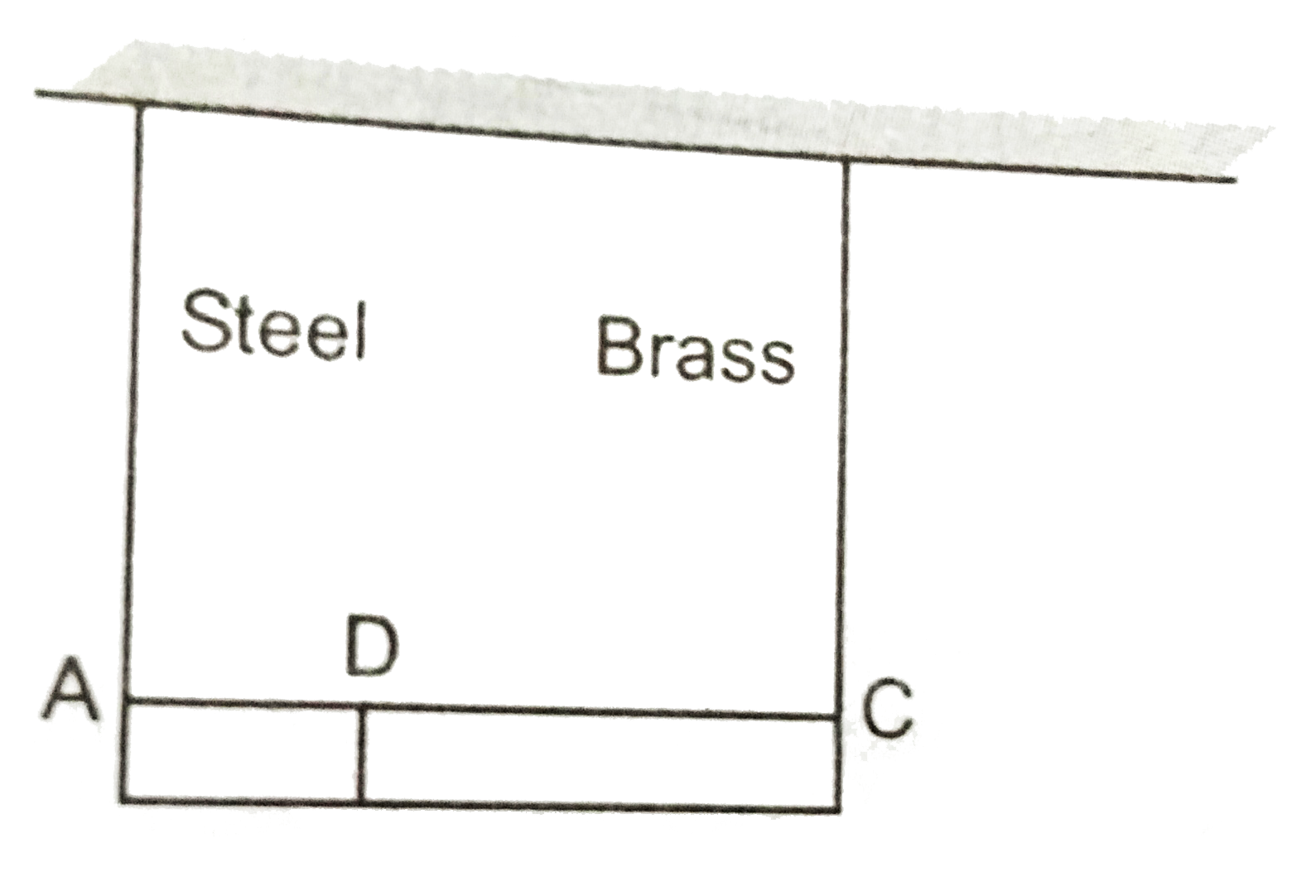 03:03View Solution
03:03View SolutionIn the above question, the position of point D from end A of the rod at which there is equal strain on both the wires is
02:23View SolutionIn the given Fig. 7(CF).2, if the dimensions of the two wires are the same and materials are different, Young's modulus is
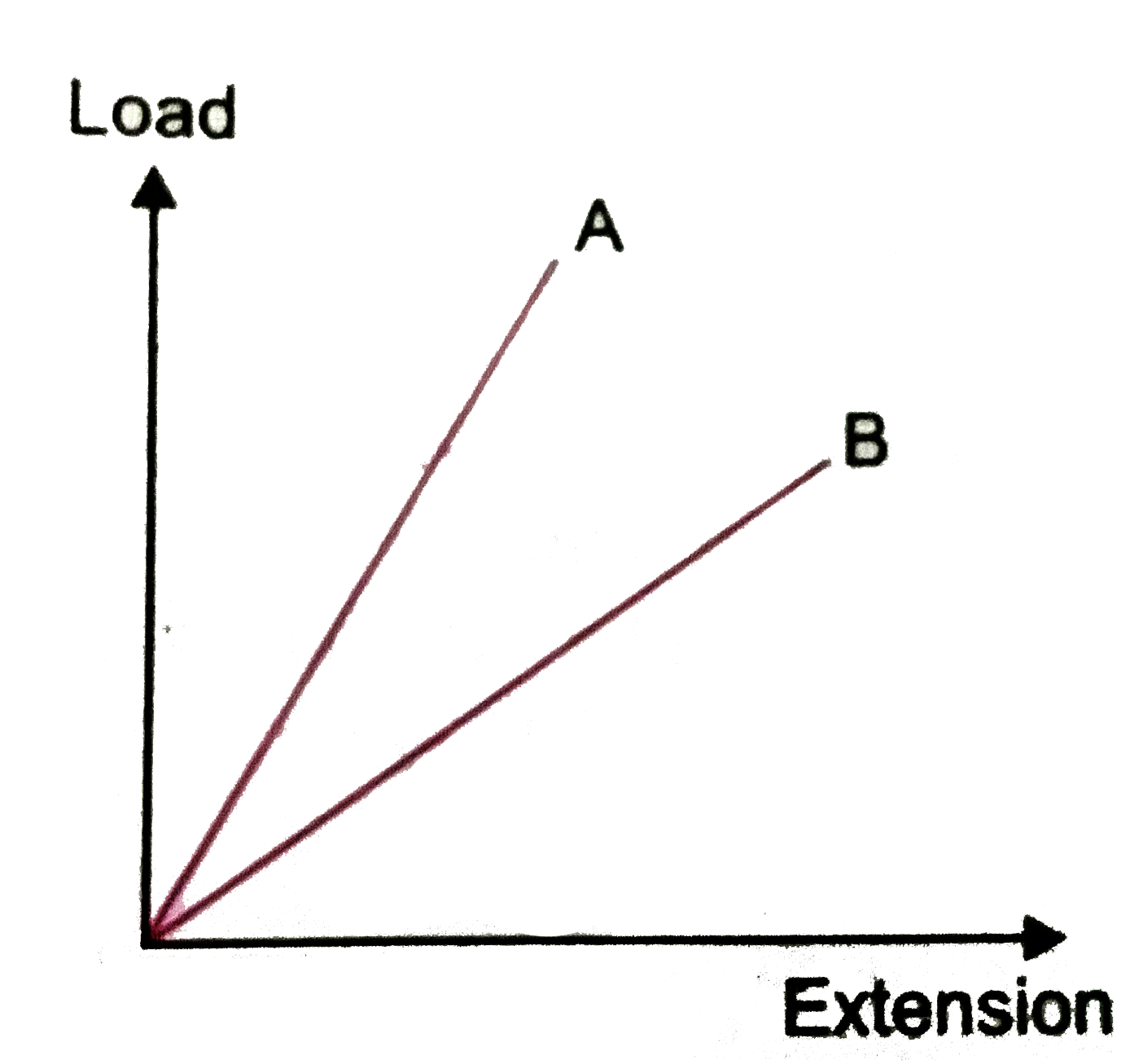 01:44View Solution
01:44View SolutionA uniform cylindrical rod of length L, cross-section area A and Young's modulus Y is acted upon by the force as shown in Fig. 7(CF).3. The elongation of the rod is
 02:03View Solution
02:03View SolutionA highly rigid cubical block `A` of small mass `M` and side `L` is fixed rigidly on the other cubical block of same dimensions and of modulus of rigidity `eta` such that the lower face of `A` completely covers the upper face of `B`. The lower face of `B` is rigidly held on a horizontal surface . `A` small force `F` is applied perpendicular to one of the side faces of `A`. After the force is withdrawn , block `A` executes faces of `A`. After the force is withdrawn , block `A` exceutes small oscillations , the time period of which is given by
04:11View SolutionCopper of fixed volume `V` is drawn into wire of length l. When this wire is subjected to a constant force F, the extension produced in the wire is `trianglel`. Which of the following graphs is a straight line?
01:57View SolutionA copper wire of length 2.2m and a steel wire of length 1.6m, both of diameter 3.0mm are connected end to end. When stretched by a force, the elongation in length 0.50 mm is produced in the copper wire. The streching force is `(Y_(copper)=1.1xx10^(11)Nm^(-2)`,
`Y_(steel)=2.0xx10^(11)Nm^(-2))`03:54View SolutionIn the above question the ratio of the elongation produced in the copper wire and steel wire are
03:54View SolutionIn the determination if Young's modulus `((Y = (4MLg)/(pild^(2))` by using searle's method, a wire of length `L=2m` and diameter `d=0.5mm` is used. For a load `M=2.5kg`, an extension `l=0.25mm` in the length of the wire is observed. Quantites `D and l` are measured using a screw gauge and a micrometer, respectively. they have the same pitch of `0.5mm`. the number of divisions on their circular scale is `100`. the contrubution to the maximum probable error of the `Y` measurement
04:34View SolutionThe upper end of a wire of radius 4 mm and length 100 cm is clamped and its other end is twisted through an angle of `30^@`. Then angle of shear is
01:30View SolutionA metal rod has length of 100 cm and cross-section of `1.0 cm^(2)`. By raising its temperture from `0^(@)C` to `100^(@)C` and holding it so that it is not permitted to expand or bend, the force developed is (Given `Y=10^(12)` dyne `cm^(-2)` and `alpha=10^(-5) .^(@)C^(-1)`)
01:42View SolutionThe mean distance between the atoms of iron is `3xx10^(-10)` m and interatomic fore constant for iron is `7 N//m`. The Young's modulus of elasticity for iron is
01:42View SolutionThe pressure that has to be applied to the ends of a steel wire of length 10cm to keep its length constant when its temperature is raised by `100^@C` is : (For steel Young's modulus is `2xx10^11 Nm^-2` and coefficient of thermal expansion is `1.1xx10^-5K^_1`)
03:10View SolutionThe length of a metal wire is `l_(1)` when the tension in it is `T_(1)` and is `l_(2)` when the tension is `T_(2)`. Then natural length of the wire is
02:00View SolutionWater is filled up to a height h in a beaker of radius R as shown in the figure. The density of water is `rho,` the surface tension of water is T and the atmospheric pressure is `P_0.` Consider a vertical section ABCD of the water column through a diameter of the beaker. The force on water on one side of this section by water on the other side of this section has magnitude
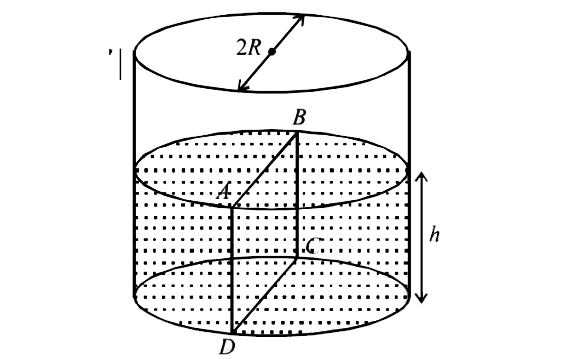 04:36View Solution
04:36View SolutionA U-tube with both ends open to the atmosphere is partially filled with water. Oil, which is immiscible with water. Is poured into one side until it stands at a distance of `10 mm` above the water level on the other side. Meanwhile the water rises by `65mm` from its original level (see diagram). The density of the oil is:
 02:56View Solution
02:56View SolutionAn ice cube containing a galss ball is floating on the surface of water contained in a trough. The whole of the ice melts, the level of water in the trough
01:59View SolutionA boat floating in a tank is carrying passengers. If the passengers drink water, the water level of the tank
01:43View SolutionA wooden ball of density ` rho` is immersed in a liquid of density `sigma` to a depth H and then released. The height h above the surface of which the ball rises will be
03:18View SolutionA glass of water upto a height of 10 cm has a bottom of area `10 cm^(2)` , top of area `30 cm^(2)` and volume 1 litre. The downward force exerted by water on the bottom is…(Taking `g=10 m//s^(2)` ,density of water `=10^(3) kg//m^(3)` , atmosphereic pressure `=1.01xx10^(5) N//m^(2)`)
03:27View SolutionIn the above question, the resultant upward force exerted by the sides of the glass on the water is
View SolutionIn making an alloy, a substance of specific gravity `s_(1)` and mass `m_(1)` is mixed with another substance of specific gravity of the alloy is
02:39View SolutionThere is a circular tube in a vertical plane. Two liquids which do not mix and of densities `d_1 and d_2` are filled in the tube. Each liquid subtends `90^@` angle at centre. Radius joining their interface make an angle `alpha` with vertical. Ratio `(d_1)/(d_2)` is :
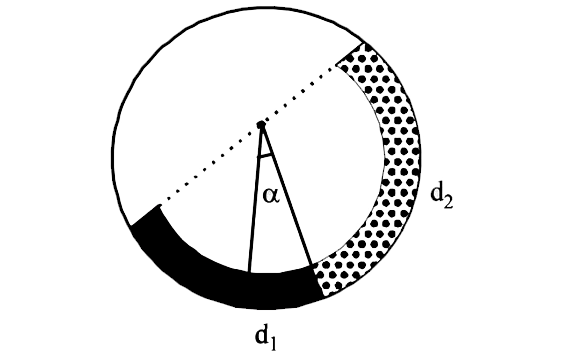 04:11View Solution
04:11View SolutionA piece of material weighing `50.0` gram is conated with 6.3 gram of wax of sp. Gravity 0.9. If the conated pice weighs 16.3 gram in water, then the density of the material in `g//c c` is
09:26View SolutionA solid uniform ball having volume V and density `rho` floats at the interface of two unmixible liquids as shown in Fig. 7(CF).7. The densities of the upper and lower liquids are `rho_(1)` and `rho_(2)` respectively, such that `rho_(1) lt rho lt rho_(2)`. What fractio9n of the volume of the ball will be in the lower liquid.
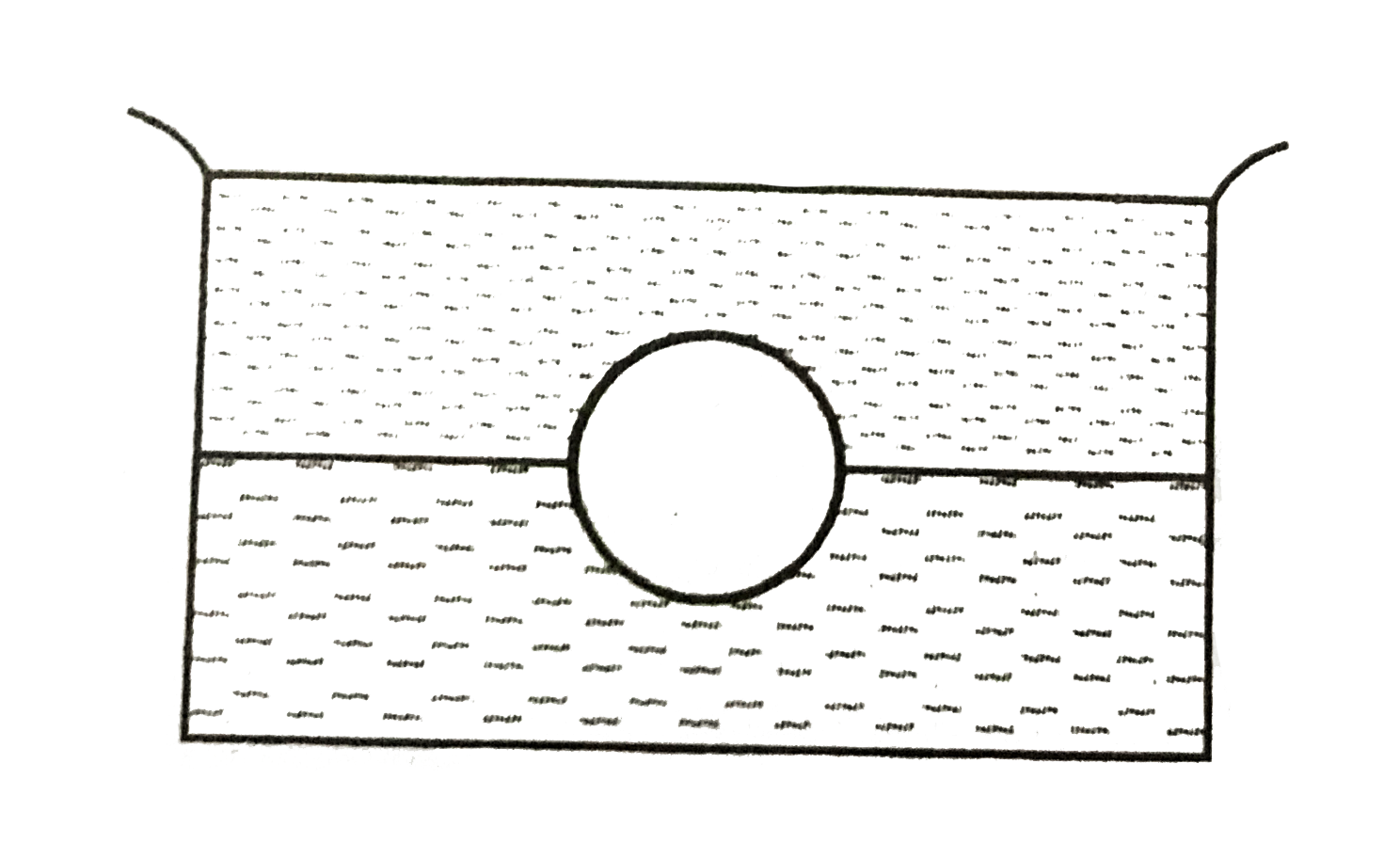 02:55View Solution
02:55View SolutionA hemispherical portion of radius R is removed from the bottom of a cylinder of radius R. The volume of the remaining cylinder is V and its mass is M. It suspended by a string in a liquid of density `rho` where it stays vertical. The upper surface of cylinder is at a depth h below the liquid surface. The force on the bottom of the cylinder bby the liquid is
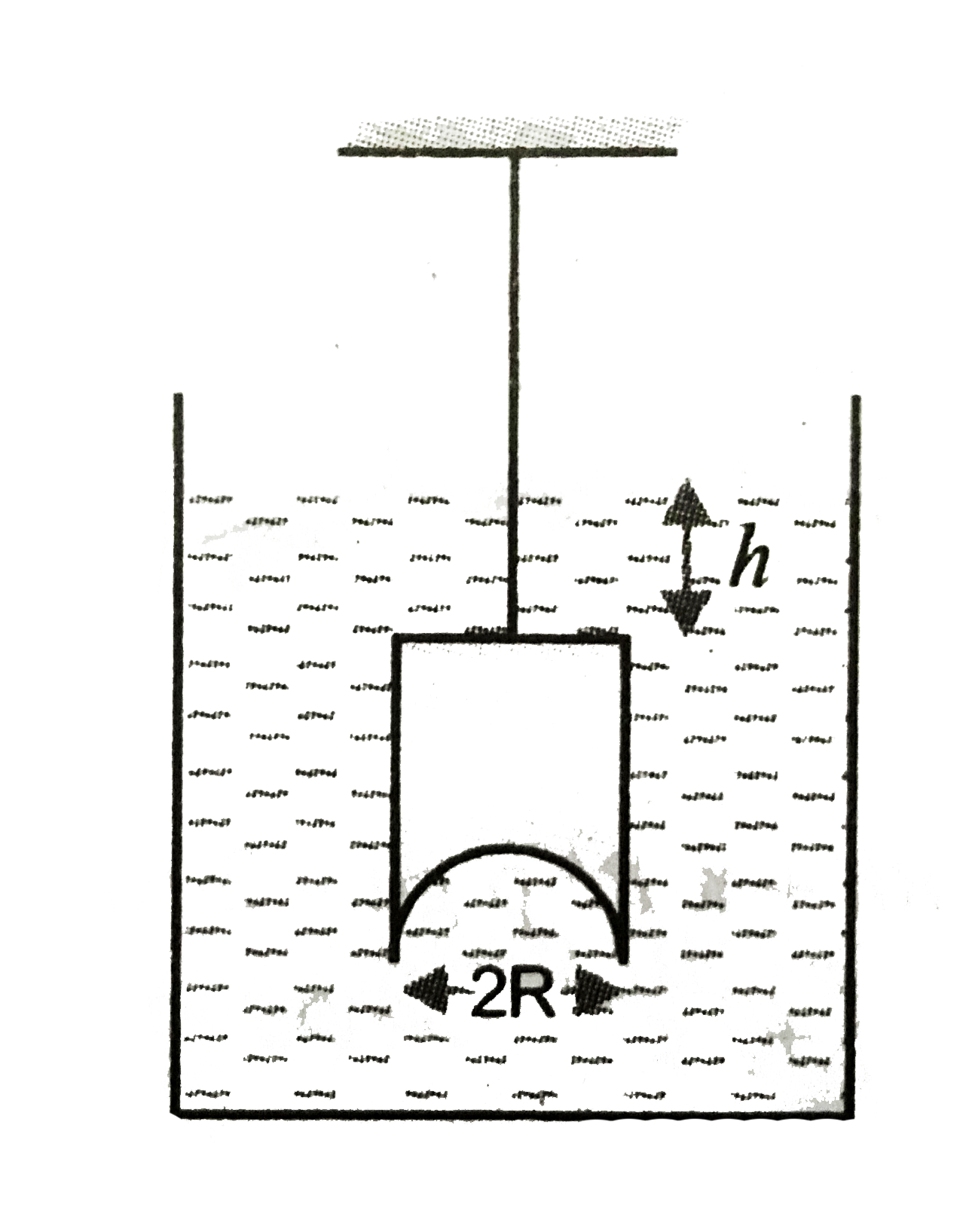 02:01View Solution
02:01View SolutionA piece of solid weighs 120 g in air, 80 g in water and 60 g in a liquid. The relative density of the solid and that of the liquid are respectively
01:42View SolutionA bird resting on the floor of an airtight box which is being carried by a boy star flying. The boy will fell that the box is now :
01:38View SolutionAn iceberg is floating partly immersed in sea water, the density of sea water is `1.03 g cm^(-3)` and that of ice is `0.92 g cm^(-3)`. The fraction of the total volume of the iceberg above the level of sea water is
02:14View SolutionAn ornament weighing `50g` in air weighs only `46 g` is water. Assuming that some copper is mixed with gold the prepare the ornament. Find the amount of copper in it. Specific gravity of gold is `20` and that of copper is 10.
02:20View SolutionA solid ball of density half that of water falls freely under gravity from a height of 19.6 m and then enters water. Neglecting air resistance and viscosity effect in water, the depth up to which the ball will go is `(g= 9.8 m//s^(2))`
03:45View SolutionIn the above question, the time taken by the ball to come again to the water surface is
View SolutionAn empty plastic box of mass m is found to accelerate up at the rate of g/6 when placed deep inside water. How much sand should be put inside the box so that it may accelerate down at the rate of g/6?
07:10View SolutionA ball whose density is `0.4 xx 10^3 kg//m^3` falls into water from a height of 9 cm. To what depth does the ball sink ?
03:23View SolutionA block of wood floats in water with `(4//5)th` of its volume submerged. If the same block just floats in a liquid, the density of liquid in `(kg m^(-3))` is
02:29View SolutionA wooden block, with a coin placed on its top, floats in water as shown in figure. The distance l and h are shown here. After some time the coin falls into water. Then
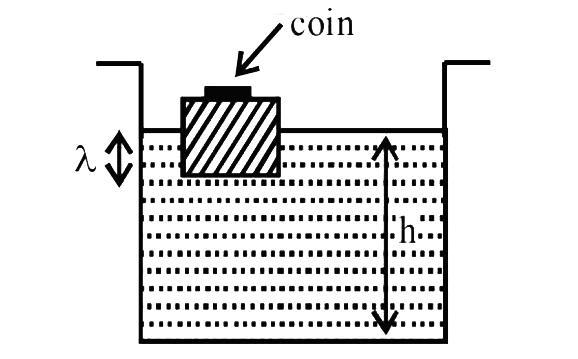 02:55View Solution
02:55View SolutionA thin uniform cylindrical shell, closed at both ends, is partially filled with water. It is floating vertically in water in half-submerged state. If `rho_c` is the relative density of the material of the shell with respect to water, then the correct statement is that the shell is
07:50View SolutionA uniform cylinder of length L and mass M having cross-sectional area A is suspended, with its length vertical, from a fixed point by a massless spring such that it is half submerged in a liquid of density `sigma` at equilibrium position. The extension `x_0` of the spring when it is in equlibrium is:
03:34View SolutionTwo non-mixing liquids of densities `rho` and `(n gt1)` are put in a container. The height of each liquid is `h`. A solid cylinder of length `L` and density `d` is put in this container. The cylinder floats with its axis vertical and length `pL(p lt 1)` in the denser liquid. The density `d` is equal to :
04:31View SolutionPressure inside two soap bubbles are `1.01` and `1.02` atmospheres. Ratio between their volumes is
02:15View SolutionA capillary tube of radius `r` is immersed in a liquid. The liquid rises to a height `h`. The corresponding mass is `m`. What mass of water shall rise in the capillary if the radius of the tube is doubled?
02:02View SolutionThe work done in increasing the size of a soap film from `10cmxx6cm` to `10cmxx11cm` is `3xx10^-4` Joule. The surface tension of the film is
02:04View SolutionWork done in increasing the size of a soap bubble from a radius of 3cm to 5cm is nearly (Surface tension of soap solution `=0.03Nm^-1`)
02:14View SolutionTwo small drop of mercury, each of radius R coalesce in from a simple large drop. The ratio of the total surface energies before and after the change is
03:44View SolutionWork `W` is required to form a bubble of volume `V` from a given solution. What amount of work is required to be done to form a bubble of volume `2V` ?
03:50View SolutionA particle is placed at the origin and a force F=Kx is acting on it (where k is a positive constant). If `U_((0))=0`, the graph of `U (x)` verses x will be (where U is the potential energy function.)
01:18View SolutionThe potential energy function for the force between two atoms in a diatomic molecule is approximate given by `U(r) = (a)/(r^(12)) - (b)/(r^(6))`, where `a` and `b` are constants and `r` is the distance between the atoms. If the dissociation energy of the molecule is `D = [U (r = oo)- U_("at equilibrium")],D` is
02:54View SolutionA certain number of spherical drops of a liquid of radius `r` coalesce to form a single drop of radius `R` and volume `V`. If `T` is the surface tension of the liquid, then
04:12View SolutionAssume that a drop of liquid evaporates by decreases in its surface energy, so that its temperature remains unchanged. What should be the minimum radius of the drop for this to be possible? The surface tension is T, density of liquid is `rho` and L is its latent heat of vaporization.
08:15View SolutionOn heating water, bubbles being formed at the bottom of the vessel detach and rise. Take the bubbles to be spheres of radius R and making a circular contact of radius r with the bottom of the vessel. If `rlt ltR` and the surface tension of water is T, value of r just before bubbles detach is: (density of water is `rho_w`)
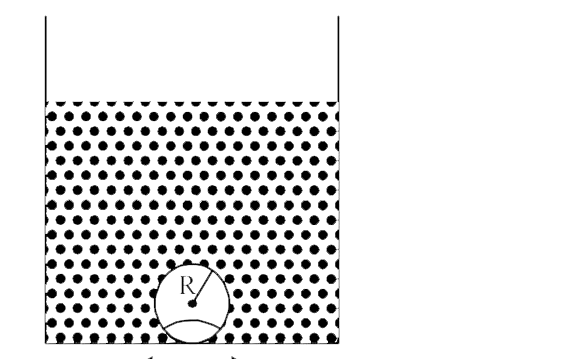 05:58View Solution
05:58View SolutionUnder isothermal condition two soap bubbles of radii `r_(1)` and `r_(2)` coalesce to form a single bubble of radius r. The external pressure is `p_(0)`. Find the surface tension of the soap in terms of the given parameters.
04:15View SolutionThe lower end of a capillary tube is dipped in water. Water rises to a height of 8 cm. The tube is then broken at a height of 6 cm. The height of water colume and angle of contact will be
01:57View SolutionThe lower end of a capillary tube of radius r is placed vertically in water of density `rho` , surface tension S. The rice of water in the capillary tube is upto height h, then heat evolved is
03:35View SolutionA capillary tube of radius r is immersed in water and water rises in to a height h. The mass of water in the capillary tube is 5g. Another capillary tube of radius 2 r is immersed in water. The mass of water that will rise in this tube is
01:39View SolutionA glass capillary tube is of the shape of a truncated cone with an apex angle `alpha` so that its two ends have cross sections of different radii. When dipped in water vertically, water rises in it to a high h, where the radius of its cross section is b. If the surface tension of water is S, its density if `rho`, and its contact angle with glass is `theta`, the value of h will be (g is the acceleration due to gravity)
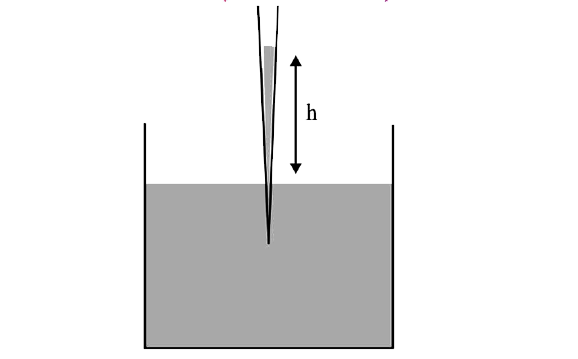 09:08View Solution
09:08View SolutionWater rises to height `h` in capillary tube. If the length of capillary tube above the surface of water is made less than `h` then
01:32View Solutionif a ball of steel (density `rho=7.8 g//cm^(3)`) attains a terminal velocity of `10 cm//s` when falling in a tank of water (coefficient of viscosity, `eta_(water) =8.5xx10^(-4)`Ps s), then its terminal velocity in glycerine `(rho =1.2 g//cm^(2), eta =13.2 Pa s)` would be nearly
03:07View SolutionThe velocity of small ball of mass `M` and density `d_(1)` when dropped a container filled with glycerine becomes constant after some time. If the density of glycerine is `d_(2)`, the viscous force acting on ball is
04:51View SolutionA small sphere of mass m is dropped from a great height. After it has fallen 100m, it attains the terminal velocity and continues to all at that speed. The work done by the air friction against the sphere during first 100m is
02:40View SolutionThe rate of steady volume flow of water through a capillary tube of length ' l ' and radius ' r ' under a pressure difference of P is V . This tube is connected with another tube of the same length but half the radius in series. Then the rate of steady volume flow through them is (The pressure difference across the combination is P )
03:25View SolutionA lead shot of 1 mm diameter falls through a long colummn of glycerine. The variation of the velocity v with distance covered (s) is represented by
02:04View SolutionTwo solild spheres manufactured of the same material freely fall down in the air. One sphere has a dimeter twice as large as the other. The force due to air resistance is proportional to the cross-section area of a moving object and is quadration function of the speed of an object and is quadration function of the speed of an object. In sometime after the beginning of motion in the presence of air resistance, the velocity of each sphere become constant. It is called the terminal velocity `v_(big)//v_(small)` is
02:20View SolutionA spherical solild of volume V is made of a material of density `rho_(1)`. It is falling through a liquid of density `rho_(2)(rho_(2) lt rho_(1))`. Assume that the liquid applies a viscous froce on the ball that is proportional ti the its speed v, i.e., `F_(viscous)=-kv^(2)(kgt0)`. The terminal speed of the ball is
01:56View SolutionTwo solid spheres of same metal but of mass M and 8M fall simultaneously on a viscous liquid and their terminal velocitied are v and n v, then value of n is
02:05View SolutionA wind with speed `40 m//s` blows parallel to the roof of a house. The area of the roof is `250 m^(2)` . Assuming that the pressure inside the house is atmospheric pressure, the force exerted by the wind on the roof and the direction of the force will be : `(rho_(air)=1.2 kg//m^(3))`
02:35View SolutionAn engine pumps liquid of density d continuosly through a pipe of cross-section are A. If the speed with which liquid passes through the pipe is v, then the rate at which kinetic energy is being imparted to the liquid by the pump is
01:15View Solution
Multiple choice questions-I questions and complete solutions for chapter PROPERTIES OF BULK MATTER of PRADEEP PHYSICS (HINGLISH) of Class 11
All Exercises from PRADEEP Class 11 PHYSICS PROPERTIES OF BULK MATTER
- Advanced problems for competitions
- Asseration - Reason Type Question
- Conceptual Problems
- Curiosity Questions
- Fill in the Blanks A
- Fill in the Blanks B
- Fill in the Blanks C
- Fill in the Blanks D
- Fill in the Blanks E
- Higher Order thinking skells
- Integer Type Questions
- Long Answer questions
- Multiple choice questions
- Multiple choice questions-I
- Multiple choice questions-II
- NCERT Questions
- Problmes for Practice
- Sample problem
- Short Answer Questions
- Solved Examples
- Test Your Grip A
- Test Your grip B
- Test Your Grip C
- Test Your Grip D
- Test Your Grip E
- Value Based Question
- Very short answer questions
